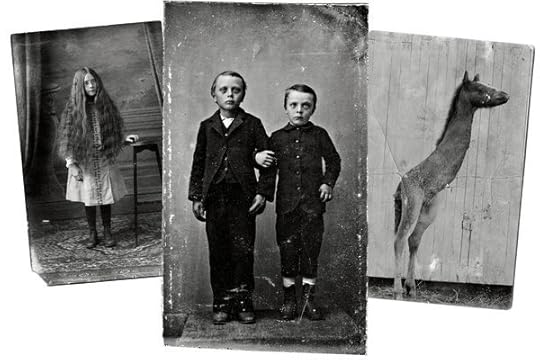Colleen Mondor's Blog, page 5
September 1, 2014
Hiroshima in the Morning by Rahna Reiko Rizzuto
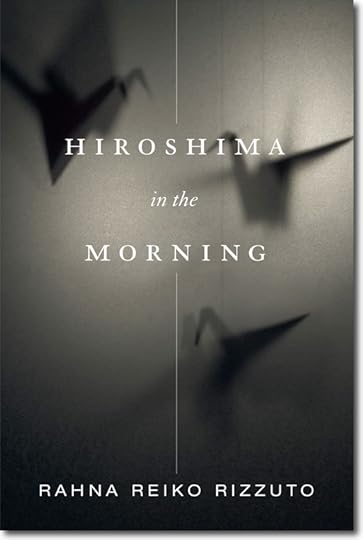 On the basis of Beth Kephart's recommendation in her book Handling the Truth, I ordered a copy of Hiroshima in the Morning through Powells. The author Rahna Reiko Rizzuto received a fellowship to go to Japan in mid-2001 for six months and research her planned novel about the bombing of Hiroshima. What she did not expect was the wrenching difficulty (in a myriad of ways) of parting from her husband and 2 young sons in NYC and how complicated it would be to navigate Japanese culture and gain the insight she wanted on her subject.
On the basis of Beth Kephart's recommendation in her book Handling the Truth, I ordered a copy of Hiroshima in the Morning through Powells. The author Rahna Reiko Rizzuto received a fellowship to go to Japan in mid-2001 for six months and research her planned novel about the bombing of Hiroshima. What she did not expect was the wrenching difficulty (in a myriad of ways) of parting from her husband and 2 young sons in NYC and how complicated it would be to navigate Japanese culture and gain the insight she wanted on her subject.
This is a really tough book to classify because if I tell you it will resonate strongly with women who feel torn between family life and their work, you will probably immediately think of "Lean In" and not give it a second thought. But that aspect of the book is important and needs to be noted. Rizzuto's personal/professional conflict is so intense and so tied to the unique aspects of researching a book, that any writer who has ever felt similarly torn is going to identify very powerfully with her words. She wonders if she is committed enough to her marriage and motherhood and also worries about her own mother who is suffering from the early stages of dementia. Are there other places where Rizzuto should be? It doesn't help when her husband starts to rethink all of his earlier support for the project after spending one too many nights dealing with sick kids. And all Rizzuto can tell him is that she is talking to people, visiting museums and temples, "soaking up" the culture of Japan.
She might be more convincing if she felt more certain that she was getting done the work she needed.
That's the other impressive aspect of Hiroshima in the Morning--Rizzuto's discovery of how complicated the Hiroshima story is. The book has excerpts from the interviews she conducted with survivors and they are the very definition of gut wrenching. Rizzuto finds herself overwhelmed by the horror of those stories, (you will be too), and transformed by them. Then 9/11 happens and her family arrives for a visit and again her vision of herself and the world goes through another change.
There is a lot about this book that made me think about writing, history, stories, the power of family and so much more. So many times as a writer I have questioned the value of what I choose to do with my life and anyone who has ever been in that position will understand what Rizzuto goes through. But the stories from Hiroshima are what has stayed with me more than anything else and they make me think yet again how much our history is dominated by the way we tell stories, and our collective acceptance of who does the telling.

August 25, 2014
Finding Evelyn
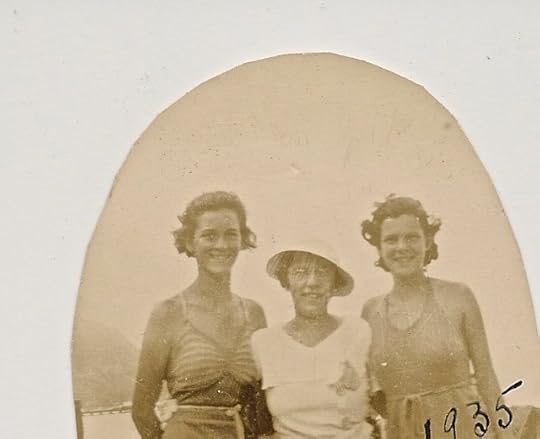
Five (!!) years ago, I posted about my grandmother's cousin, Evelyn. She died relatively young of a disease (I thought typhus) that was caught from a used mattress. Her toddler son died as well. At the time, I did not know Evelyn's married name nor her husband's name nor her year of death. All I knew was that she and my grandmother were quite close as evident from the many photos of them together.
Soooo...a couple of months ago I decided to get serious about Evelyn. Her mother was one of my great grandmother's younger half sisters and I hope to track down this missing branch of the family and learn more about my great grandmother's childhood from them. Also, I just wanted to find out what happened.
I searched through census records and found her with her married name. I found two marriages for her, both to Joseph Baranello. One was in 1933 which makes sense as her first child was born in 1934. The second was in 1937. They are the exact same names so I think it's unlikely that one of these marriages was a different couple. I have no idea why they got married twice but I'll run this down eventually, if only because the weirdness can't be ignored.
With her married name I easily found her death record and also that of her baby boy, Richard, who died two weeks before.
As it turns out, Evelyn died on my birthday in 1940. That kind of freaks me out a bit because I come from people for whom signs are everything. (Blame Catholicism and all those saints.) Evelyn and I had more in common than I thought.
She did die from a communicable disease. It looks like diphtheria from the certificate although I will have to follow up for another report apparently to know for sure. Her coffin however was ordered hermetically sealed (written in hand down the side of the certificate). This was established practice for communicable diseases at the time. And now I have the cemetery where she was buried although I won't be following up on that. (Because really - $105 to find out who she is buried with is just a bit high to me.)
Evelyn was 23 years and 10 months old when she died. She had two older daughters, Joan & Barbara Baranello. According to my grandmother, their father took them away and they were never seen again. I was told he was from South America or "someplace like that," except from census records he seems to be have been born in NYC in 1916. Finding Joan and Barbara (and their descendants) will require some more work, I know but finding them might mean more answers about my great grandmother's mother who is the real mystery in all this. So I'll keep looking but at least now I have Eveyln, and that is something good.
Just look at how happy she is in that picture. She smiles in every photo I have of her.
[Post pic from l-r, my grandmother Catherine, Marie Gonzales, Evelyn Baranello. Marie was Evelyn's mother and my grandmother's aunt. Taken 1935 - my grandmother was 16, Evelyn was 19, Marie was 38.]

August 13, 2014
UPDATED!! - Cursing a clerk who did not write clearly in 1895
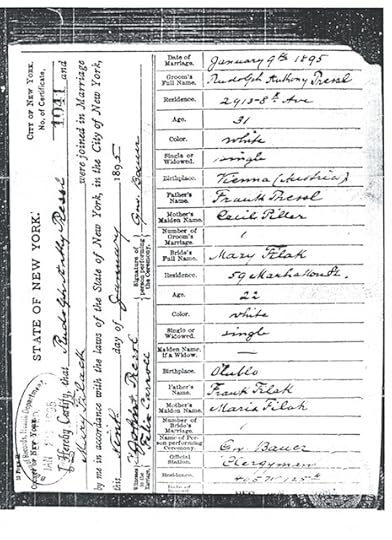
This is the marriage certificate for my great great grandmother and her husband (who was not my great great grandfather). It has given me a lot of information including, on the 2nd page (which I did not scan), her signature. That finally proved her true name was Maria Filak. As her first and last names are spelled differently in all sorts of census records, it was nice to have that proven. (Even here they screwed up though--as you can see the clerk wrote in "Mary Filak".)
My problem is Maria's address. It is listed under her name and the number, "59", is clear but the street name gets unclear. Starts with an "M", has an "h", maybe a "c". It looks like a "St" at the end--a capital cursive "S" is pretty clear. But what street is this? Marchallow St? Hmmm - doesn't show up I'm afraid.
I just don't know.
The groom's address is 2913 8th Ave and the clergyman who married them was from 405 W. 125th St in Harlem, which I found out online is St Joseph of the Holy Family. (The oldest church in Harlem as it turns out.) But Maria's place of residence is a mystery to me and she is the one who matters most. Her whereabouts between 1886, when she arrived in NYC and 1895, when she married Rudolph, are unknown. In that period she gave birth to my great grandmother, whose father is also unknown. So pinning down any hint as to where Maria was is a very valuable clue in my family history search.
If any of you recognize the street, give me a shout. I'd appreciate any help I can get.
UPDATE: And it looks like we have a winner! We are thinking it is "Manhanttan St." which makes sense as, according to Wikipedia, "West of Convent Avenue, 125th Street was re-routed onto what was formerly called Manhattan Street prior to 1940." That puts us right in the neighborhood of the church! So now I find out what was there in 1895 and try to piece together more of Maria's mysterious life....
Big thanks to Melissa Posten for helping me out on this the second I posted to facebook & everyone else who sent emails. You guys rock!!

August 12, 2014
Considering the masterful plotting of Miss Peregrine and Hollow City
I just read and enjoyed immensely Ransom Riggs's Hollow City, the sequel to Miss Peregrine's Peculiar Children. Fans of the first book need only hear that the second exceeds it in every way, (which is pretty amazing as that book was fantastic), and those who have missed both and love a good story (regardless of whether you like young adult, new adult or just plain adult) really ought to read these books immediately.
But what I've been thinking about is what a good job Riggs did at crafting both of these books around the photographs he illustrates them with.
Riggs finds odd photographs in the usual settings: flea markets, antique stores and via collectors. In Miss Peregrine many of these were comprised of the individuals who made up the story: the peculiar children. In Hollow City he goes much further in using photos to illustrate not only people the children meet (and animals) but also significant events that occur throughout the novel. Clearly, the pictures were key to plot development and how he accomplished this is truly inspiring to me as a writer.
The other thing about the 2 books is that they remind readers how pleasurable it is to read illustrated novels. I greatly enjoy Barbara Hodgson's novels for this reason and Riggs has made me a big fan with how well he integrates his quirky postcards (which Quirk Books presents so beautifully in these lushly designed editions).
As to the plot--there's time travel (primarily late 19th to mid 20th century), "peculiar" children with all manner of odd talents (control of bees, weighing lighter than air, communicating via echolocation, etc.), and a major war between good and evil (of course!). World War II plays a big part in Hollow City, which allowed Riggs to use some evocative images (including the cover) and also amps the peril the main characters find themselves in.
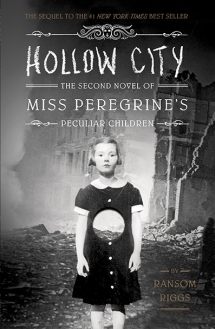 But.....none of that is why I wanted to write about these books. My biggest reason to recommend them is to persuade adults to give them a go. Yes, there is a slight teenage romance going on here but it is subtle and kind and will ring true for many. More importantly the overall story is escapist fiction at its best; thrilling, creepy, smart and also quite hopeful. It's like nothing else I have read and reminds me a lot of Bradbury at his Something Wicked This Way Comes best.
But.....none of that is why I wanted to write about these books. My biggest reason to recommend them is to persuade adults to give them a go. Yes, there is a slight teenage romance going on here but it is subtle and kind and will ring true for many. More importantly the overall story is escapist fiction at its best; thrilling, creepy, smart and also quite hopeful. It's like nothing else I have read and reminds me a lot of Bradbury at his Something Wicked This Way Comes best.
Good books + cool photos. What's not to love? :)
Read Chap 1 of Hollow City at Ransom Riggs's site.

August 7, 2014
Born in America but not an American
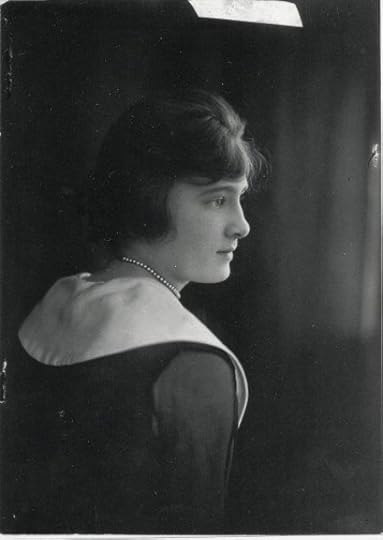 This ranks as the weirdest thing I have discovered thus far in my family history research.
This ranks as the weirdest thing I have discovered thus far in my family history research.
My great grandmother had three younger sisters: Marie, Ernestine & Carol. All three of them were born in NYC (1895, 1897 & 1900). I knew they were born in NYC because all of their birth certificates are available online. These are not "people we heard were born in NYC" or "people we thought were born in NYC" but 100%, no doubt, for sure, born in NYC.
So imagine my surprise when I found Carol's naturalization papers.
I tracked Carol through the census records in the early 1900s, just as I tracked her sisters. I knew her husband's last name was Redmond and he showed up with her in the 1930 census (first name Frank). (I have no idea why they aren't in the 1920 census but I'll worry about that later.)
I knew Carol's son's name was Warren (I actually have a postcard he sent my great grandmother when he was in WWII) and there was was Warren, born in 1927. Everything about Carol was lining out as I expected, and I was just filling in the necessary blanks.
Then ancestry.com sent me a hint about Carol with a link to a naturalization record. This made no sense but I looked and there she was, my great great aunt Carol, with her place of birth in NYC applying for citizenship in the US in 1939. There is no doubt about this being my Carol (how many Caroline Freida Redmonds can there be in the world?), but it made no sense. The one thing that really jumped out at me was that the application stated she and Frank were married in Barbados and he was born in NYC in 1903.
None of this made any sense.
It got more complicated when I searched for her marriage certificate online and found it in 1919 in NYC. (Which is clearly not Barbados.) So....I think the clerk on the naturalization papers might have flipped it--Frank was born in Barbados and they were married in NYC. (According to the 1940 census, Frank was born in the British West Indies.)
But that's all Frank and not Carol and where Frank was born should not affect Carol's citizenship except....it actually did.
According to the National Archives website, there was a lot of confusion at the turn of the century over female citizenship. Just as foreign women became citizens upon marriage, the courts began to decide that American women could lose citizenship upon marriage to a foreigner. It finally became law in 1907. Under the act of March 2, 1907, all women acquired their husband's nationality upon any marriage occurring after that date.
If a husband eventually filed paperwork and naturalized into a US citizen, the woman then became an American....again. But if the husband did not obtain US citizenship for whatever reason, then the woman couldn't either because it was all totally up to the man. Basically, a woman born in the US, who lived her whole life in the US and never ever left the US could still cease to be a US citizen if she married a man who wasn't an American.
(My inner historian is screaming all about the 14th Amendment right now.)
Frank must have been British still at the time of their marriage and when Carol married him, she lost her US citizenship. Now why she applied in 1939 is still a mystery. I can find no record of Frank applying for citizenship however so perhaps Carol applied to get hers back after the laws changed again (and got rid of this insanity). Oddly enough, I think when she became a citizen in 1939, that would automatically make Frank one if he had never sought citizenship before. (Because, after all, he was then married to a US citizen. AGAIN.)
Maybe. Honestly, I have no clue at this point.
The key bit in all this is that Carol was born in America, fell in love in America, got married in America and then lost her American citizenship.This happened because Carol was a woman. It really makes all this immigration stuff today seem even crazier when you realize that once upon a time in this country even being born here wasn't enough.
I have ordered a copy of Carol & Frank's marriage certificate. Can't wait to see what that reveals.....
[Post pic of Carol, about age 15.]

August 4, 2014
Photos from the sky in 1926
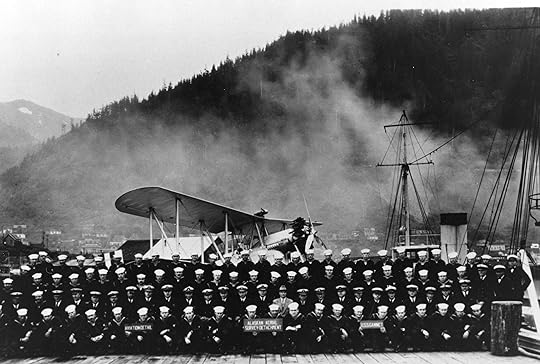
From my article on the survey of Southeast Alaska up at Alaska Dispatch News:
In 1926 Alaska's aviation industry had barely been born. Ben Eielson had flown and lost the first air mail contract in 1924. Russ Merrill and Roy Davis made the first flight over the Gulf of Alaska only one year before. And future famous pilots like Bob Reeve, Joe Crosson, Bob Ellis and Shel Simmons had yet to make their marks. But as reported in the 1929 publication "Aerial Photographic Surveys in Southeastern Alaska," using aircraft to survey the territory was a logical choice. Although topographic mapping of Alaska had been conducted by the Geological Survey for nearly 30 years, progress remained slow-going and extremely hazardous with some regions still stubbornly inaccessible. Photographing by aircraft presented endless possibilities; it just needed to be tested.
It's just amazing when you think of what they accomplished with such crude equipment and poor weather reporting information. I'm always so surprised when I come across stories like this--so much history just waiting to be discovered.
[Post pic courtesy US Forestry Service]

July 28, 2014
The Giant Squid, its first photographer & a writer's obsession
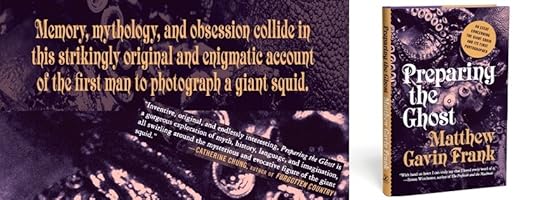
Preparing the Ghost by Matthew Gavin Frank is without a doubt one of the more unusual books I have read in a long time. Described as "an essay concerning the giant squid and it's first photographer" it is, in my mind, first and foremost a writer's book. (Not that the natural history isn't fascinating.) It's about a writer (Frank) obsessed with a Victorian era naturalist and photographer (Harvey Moses) who was obsessed with the Giant Squid which he famously photographed in Newfoundland in 1874. There is also much here about humanity's obsession with the Giant Squid and the vast amount of mythology, literature and more that has developed around this still mysterious creature.
One of the most successful aspects of Preparing the Ghost is Frank's authorial voice--he is a key component to this surprisingly personal story and as much as it is about the life of a man in Newfoundland from more than a century ago, it is also, deeply, about Matthew Gavin Frank. On more than one occasion he veers into his own past trying to mine it perhaps for reasons why he has succumbed to this obsession. Standing in front of Moses's home, (privately owned) knocking on the door yet again and hoping for a glimpse of the bathroom where the squid was draped and photographed, Frank can't explain why he is very desperate to get inside. He keeps knocking, he keeps returning, he keeps hoping for a glimpse of where history was made and he knows enough to know that this stubborn persistence is part of the story he is telling and, written well, it is as compelling as every other aspect of the tale.
Preparing the Ghost reminded me a bit of Geoff Dyer's Out of Sheer Rage: Wrestling with D.H. Lawrence. Very famously, that book is about not writing a book about D.H. Lawrence and in some significant ways Preparing the Ghost is about not writing a book about the Giant Squid. Just as Dyer does write somewhat about Lawrence, so does Frank write about the squid. But there is also much more here about Newfoundland and houses and marriage and family and leaving home and traveling far and fishing and telling stories and lying while taking stories, (like confusion over who the fishermen were who caught the squid), and, of course, it is about how something like a squid could spawn stories that grew into myths and even now, has sparked a book about all of that.
I enjoyed the hell out of this book due in no small matter, I'm sure, to the fact that I've long been fascinated by the Giant Squid. I loved how Frank wrote around and about his subject and thoroughly enjoyed his appreciation of history. It's an odd little book in some respects--the narrative truly jumps all over the place--but Dyer's book is odd as well and what lifts both of these titles is the enormous curiosity and smarts of the authors. They are candid about their obsessions and frustrations and persevered to create something unique to literature. I learned a lot about the Giant Squid while reading Preparing the Ghost but even more so, I learned about writing. Highly recommended.

July 23, 2014
"But this summer is different."
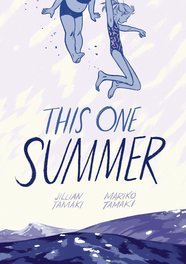 The graphic novel This One Summer by cousins Jillian and Mariko Tamaki is one of those books that really requires a teen sensibility to fully appreciate. Adults can certainly read it (and enjoy it) but I think if you are a 12 or 14 year old (girl especially) then This One Summer would have special appeal.
The graphic novel This One Summer by cousins Jillian and Mariko Tamaki is one of those books that really requires a teen sensibility to fully appreciate. Adults can certainly read it (and enjoy it) but I think if you are a 12 or 14 year old (girl especially) then This One Summer would have special appeal.
The set-up echoes the plots of many other summer novels from the past: Rose and her parents arrive at their cabin in Awago Beach for their annual vacation. Windy and her mother and grandmother are nearby, just as they are every year. Rose and Windy are set for some familiar hijinks: hanging out at the beach, bonfires and picnics, bike rides and, this year, renting some classic horror movies from the local store and getting the crap scared out of them them while their parents are none-the-wiser.
There are some serious undercurrents however--Rose's parents are in a troubled marriage and the source of their conflict, which plays out in dozens of little tense-filled moments throughout the book, is an ongoing object of concern for Rose. Also, she develops a small crush on the high school boy who works at the store and his turbulent relationship with a local girl becomes something she and Windy study with great interest. How couples work, or don't work--the whole concept of romantic love--is the mystery that unfolds for Rose as the summer continues. Windy is a little younger and for her it is mostly a game to watch but for Rose, there is a wistfulness that anyone who survived middle school will recognize. She pines for something that she is not yet old enough to understand. (This is pretty much everything you need to know about middle school.)
This One Summer isn't a sweet story though. The girls are pretty typical girls. They sling a few bad words around, testing them out for effect, and they are all about noticing the older teens, what they have, what they do, how they interact. The girls listen for everything and gather information on sex and flirting, pondering it like miniature Jane Goodalls in the wild. This is where reviewers really and truly must channel their inner teen to appreciate the book and understand how important and common these interactions are and how brilliantly the author and illustrator nail the essence of teenage girl.
[Momentary aside--I can still tell you the names of the first girl and boy in my 6th grade class to make out. I can't tell you much else I learned that year but Gary & Leighann, those two, (and the drama their kissing brought to a hundred lunchtime conversations when I was 12), I will never forget.]
I will be very surprised if This One Summer is not challenged at some point. There are parents who will not be happy to see the language or the sexual suggestions that Rose & Windy spy on. And I'm also sure there are reviewers who will say that not enough happens in this story or that the events are too melodramatic. For me though, it all rang as spectacularly authentic. Teenagers sit around and talk about each A LOT. They flirt, they fall in and out of relationships and sometimes things move far too quickly. Younger teens study the big kids, they follow, they stare, they spend hours talking about what they see. Not a lot happens in This One Summer but it is about as true to real life for most kids that you could hope to find.
That's why it's going to get challenged, and also, why so many teenagers, (again, girls especially), are going to read it again and again.

July 21, 2014
Longmire + some Charles de Lint-like fantasy = Deborah Coates' "Strange Country"
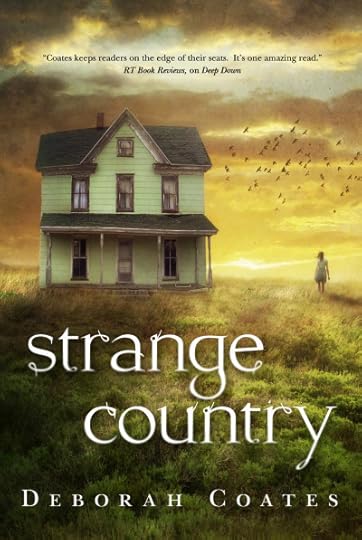 Hallie Michaels first appeared in Deep Down as an Afghanistan vet who returned home to South Dakota after the unexplained death of her sister. Hallie was unusual not in that she had been injured while serving in the US Army but because she actually died--for 7 minutes--and came back. In South Dakota she found her father, a childhood friend and an attractive man in the person of Deputy Boyd Davies. She also found out that her sister shouldn't be dead, that there were mysterious forces at work in her hometown and magic was in the air.
Hallie Michaels first appeared in Deep Down as an Afghanistan vet who returned home to South Dakota after the unexplained death of her sister. Hallie was unusual not in that she had been injured while serving in the US Army but because she actually died--for 7 minutes--and came back. In South Dakota she found her father, a childhood friend and an attractive man in the person of Deputy Boyd Davies. She also found out that her sister shouldn't be dead, that there were mysterious forces at work in her hometown and magic was in the air.
Oh, and Hallie was in the middle of everything.
In Wide Open the story continued with the character of Death and the thin line between here and there and Hallie's precarious position as someone once dead putting her at extreme risk. There was also a lot about the weather (really) and Boyd's ex-wife, and plain old murder.
Now, in the final book in the trilogy, Strange Country, a very old mystery surfaces and Hallie and Boyd (and the sheriff's office) must investigate. There are still lingering remnants of magic, especially around Hallie's ranch, and the couple is entirely comfortable with the fallout from Wide Open. (This is where I tell you that you really have to read these books in order.)
But initially, with a murder by bullet, it seems like Strange Country won't be as much rural fantasy as police procedural (albeit with a few supernatural twists). But then Boyd starts following clues and making discoveries and before you know it there is a discussion about going to see Death, threats from the other side and lots of bad feelings (as in "I've got a bad feeling about this").
By Strange Country readers know Hallie well and they trust her. We like her because she is smart and thoughtful and not afraid to say she is sick and tired of the crazy that her life has become but still determined to do what she has to do to get stuff sorted out. Her relationship with Boyd has matured as has her friendship with gal pal Brett. Her father is only a whisper of a character in this outing (which is a shame) but there are appearances by several residents from town and the sheriff's department never disappoints. in fact we have so much invested in Hallie and Boyd and crew that the stakes seem much higher now--we really don't want anything to happen to anybody.
Yeah. We're going to get hurt. (Although I will say that it's okay to love all the horses and the dogs as none of them die.)
The Hallie Michaels series is not terrifying nor edge-of-the-seat-thrilling and I feel like I'm underselling it by simply saying that it is solidly entertaining. But these are good books--enjoyable books. I like the characters, I like the setting and I like watching the plots unfold. Hallie became a friend very quickly and that is cemented by the time we get to the end of book 3. We rarely see urban fantasy in the west, let alone South Dakota (thus the rural fantasy tag here) and I welcome it. I hope Coates returns to West Prairie City at some point in the future and gives us more of Hallie and Boyd (and Maker and the rest). She has created something that hits all the marks with these books and I'm sorry to have turned the last page.

July 17, 2014
Ancient Oceans of Central Kentucky
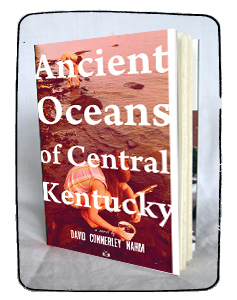 Oh, this is such a bleak book.
Oh, this is such a bleak book.
It feels small to write that because I don't think bleakness is truly appreciated anymore. We get our heartstrings tugged so frequently, so casually by many authors. What David Connerley Nahm does with Ancient Oceans of Kentucky is much more than convenient sadness as a plot point though. He takes sorrow to a whole other level and infuses this novel with so many careful layers of emotion that you feel drained by the end.
This is bleakness of the Scottish moors in a 19th century novel kind of sadness and the fact that it takes place today in Kentucky is just another layer of heartbreak.
The plot hinges on the childhood disappearance of Jacob, the little brother of protagonist Leah. There is no mystery here though--the missing boy is deep in Leah's past and there are no police to swoop in now and uncover clues and find him (living or dead). Jacob's disappearance is just the first of many haunts in Leah's life, the ghost that she revisits as the narrative wanders back and forth in time and Jacob disappears again and again in her memory.
It is not surprising that Leah has not gotten over the loss of her brother or wishes still for that thing we call (so casually) "closure". But Namh doesn't just give readers a character with an eye on the past; he gives us overworked Leah at her non-profit job helping desperate families in desperate situations and failing again and again at giving them what they need. (And not even trying for what they might want.) Leah can't save these people--there is no money to save them, no resources, no places to take them in or programs to give them assistance. All she can do is try and as anyone who reads the news these days knows, all the trying in the world isn't enough for all the need.
Leah is overworked and underpaid (of course). She's lonely and sad and can't forget her brother (of course). She feels guilty for what she said and did and didn't do when they were kids (of course). Her family was never the same after Jacob disappeared and now, she doesn't seem to remember what a family is anymore or why it matters. And she watches all the families come in her door and their disappointments break her heart even more. And then, maybe, Jacob comes back.
In some ways Ancient Oceans of Central Kentucky seemed almost too much for me to bear as a reader. But for all that this book includes a child abduction (a very unusual event), it is primarily a story of the most mundane aspects of life. It is about getting by, about hanging on, about the falling apart that happens when a family doesn't pull together. There are a thousand familiar stories in Leah's days and as Nahm uses her to anchor his novel, he touches on many of them. His fiction thus forces us to open our own eyes a bit more, to look a little deeper, to recognize the bleakness that fills our world.
The back cover copy says that "Ancient Oceans of Central Kentucky is a wrecking ball of a novel..." This is incredibly true; it reminds us just how horrific a wrecking ball truly is.


